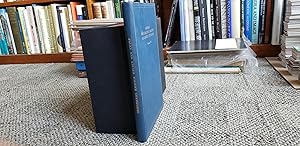About this Item
FIRST EDITION. viii, 183, [1=ads] pp; portrait. Original cloth, large 8vo. Near Fine. 'Norbert Wiener was proving important results in areas of interest to Paley so he applied for a Rockefeller International Research Fellowship to allow him to travel to the United States to collaborate with him at the Massachusetts Institute of Technology. Norbert Wiener wrote in [2]: 'Soon after his arrival in America, however, certain studies of lacunary series which Paley had already begun suggested a new attack on the theory of interpolation and allied trigonometrical problems. These results led successively to the study of quasi-analytic functions, of entire functions of order one-half, and of many related questions.' For a young man of 26, Paley had collaborated with a remarkable group of mathematicians. In addition to Littlewood, Zygmund and Norbert Wiener, he had also collaborated with Pólya. As Norbert Wiener wrote in [2]: 'Possessed of an extraordinary capacity for making friends and for scientific collaboration, Paley believed that the inspiration of continual interchange of ideas stimulates each collaborator to accomplish more than he would alone.' Already with a reputation remarkable for one so young, Paley stood on the brink of becoming one of the very first rank of research mathematicians. However, in 1933 while working in the United States, he went to Canada for a skiing holiday. While skiing near Banff he was killed by avalanche [1]: '. . . at Deception Pass, Fossil Mountain in the Rockies. Park wardens and a member of the Canadian Mountain police recovered the body, which has been brought to Banff. Mr Paley was skiing alone at an altitude of 9,600 ft, but his death was witnessed by companions lower down the mountainside.' Had he lived to continue his mathematical work, one feels sure that his name would today be as well known as the mathematicians with whom he collaborated. Norbert Wiener gave the Colloquium Lectures of the American Mathematical Society in 1934 and spoke on Paley's work. Paley was to have been a Colloquium Lecturer himself. Norbert Wiener wrote in [2]: '. . . he was already recognised as the ablest of the group of young English mathematicians who have been inspired by the genius of G H Hardy and J E Littlewood. In a group notable for its brilliant technique, no one had developed this technique to a higher degree than Paley. Nevertheless he should not be though of primarily as a technician, for with this ability he combined creative power of the first order. As he himself was wont to say, technique without 'rugger tactics' will not get one far, and these rugger tactics he practised to a degree that was characteristic of his forthright and vigorous nature' ' (J J O'Connor and E F Robertson, Paley entry at MacTutor History of Mathematics Web site; sources are N Wiener, 'R E A C Paley - in memoriam', Bull. Amer. Math. Soc. 39 (7) (1933), 476, and an obituary, The Times).
Seller Inventory # 21014
Contact seller
Report this item

